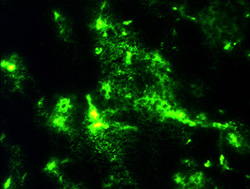Tumors Grow Faster Without Blood-Supply Promoting Molecule
November 9, 2008
By Susan Brown
Dense networks of blood vessels thought to spur cancer's growth could actually hinder rather than promote tumor progression, according to a new study at the University of California, San Diego.
The findings partly explain why drugs designed to treat cancer by strangling its blood supply have been disappointing when used alone and why those treatments are more effective when combined with traditional chemotherapy.

Blood marked with fluorescent dye spills from a tumor's leaky vessels.
Despite their rapid progression, tumors fed by more normal vascular were also more vulnerable to the effects of standard chemotherapy drugs, the team reports in this week's early online edition of the journal Nature.
Nascent tumors take off as new blood vessels invade, an event called angiogenesis that many see as key to the development of malignancy. But those pathological vessels form tangled structures that are far from normal.
"Tumor blood vessels become more chaotic, disorganized and leaky," said Randall S. Johnson, professor of molecular biology at UC San Diego who led the study. "They become dysfunctional in many ways as a blood vessel network."

Without the growth factor, VEGF, blood vessels stay intact.
Cellular secretions within tumors promote the invasion. The first drugs designed to curtail cancer's blood supply targeted one of these, called VEGF for vascular endothelial growth factor. Inflammatory cells, which infiltrate many types of tumors, provide one source of VEGF.
Johnson's team created a strain of mice in which most inflammatory cells were missing the gene for VEGF, then cross-bred them with a strain that reliably develops mammary tumors and is commonly used to study breast cancer.
"The blood vessels look more organized and less leaky in the engineered mice," said Christian Stockmann, a molecular biology postdoctoral fellow and the first author of the paper.
The blood supply to tumors in these mice was also sparse compared to mice with intact VEGF genes.
"A lot of these classic hallmarks of tumor blood vessels disappeared when the inflammatory cells couldn't make VEGF," Johnson said.
But the cancer grew faster.
All of the mice developed tumors, but at 20 weeks of age, those with low levels of VEGF from inflammatory cells had larger growths that were more likely to have progressed to a later stage of cancer.
"The tumors seemed much happier when they didn't have this chaotic vasculature," Johnson said.
The scientists also injected a cancerous cell line into normal and engineered mice and found that the introduced cells invaded normal tissues more readily without VEGF from inflammatory cells and developed more normal blood supplies.
The tumors that formed were also more susceptible to two different chemotherapy drugs in the mice lacking VEGF from inflammatory cells.
By identifying the cellular source of the critical factor for one pathology associated with cancer, the researchers say their findings may open new avenues for treatment.
The National Institutes of Health funded the research.
